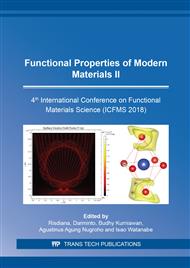[1]
Y. Shao, L. Zhou, C. Bao, J. Ma, A facile approach to the fabrication of rattle-type magnetic carbon nanospheres for removal of methylene blue in water, Carbon 89 (2015) 378-391.
DOI: 10.1016/j.carbon.2015.03.047
Google Scholar
[2]
D. Tahir, S. Ilyas, B. Abdullah, B. Armynah, H. J. hang, Electronic properties of composite iron (II, III) oxide (Fe3O4) carbonaceous absorber materials by electronic spectroscopy, J. of Elec. Spect. Rel. Phen. 229 (2018) 47-51.
DOI: 10.1016/j.elspec.2018.09.008
Google Scholar
[3]
B. Abdullah, S. Ilyas, D. Tahir, Nanocomposite Fe/Activated Carbon/PVA for Microwave Absorber: Synthesis and Characterization, J. of Nanomat. 2018, article 10 9823263, 6 pages.
DOI: 10.1155/2018/9823263
Google Scholar
[4]
T. Li, Y. Li, C. Wang, Z-D. Gao, Y-Y. Song, Nitrogen-doped carbon nanospheres derived from cocoon silk as metal-free electrocatalyst for glucose sensing, Talanta. 2015. PII. S0039-9140 (15) 30222-8.
DOI: 10.1016/j.talanta.2015.08.005
Google Scholar
[5]
S. Zhou, J. Li, F. Zhang, T. Zhang, H. Huang, Dispersible mesoporous carbon nanospheres as active electrode materials for biomolecular, Micro. Meso. Mater. 202 (2015) 73-79.
DOI: 10.1016/j.micromeso.2014.09.052
Google Scholar
[6]
Y. Xie, Y. Song, L. Xu, C. Peng, L. Wang, Cu metal-organic framework-derived Cu nanospheres porous carbon/macroporous for electrochemical sensing glucose, J. Alloys. Comp. 2018. PII.S0925-8388 (18) 31743-2.
DOI: 10.1016/j.jallcom.2018.05.064
Google Scholar
[7]
M. Ljiu, T. Zhang, H. Ren, L. Wang, T. Meng, J. Zhao, H. Wang, Nitrogen-doped hollow carbon nanospheres for highly sensitive electrochemical sensing of nitrobenzene, Mater. Res. Bullet 104 (2018) 15-19.
DOI: 10.1016/j.materresbull.2018.04.005
Google Scholar
[8]
L. Zhou, G. Xie, X. Chen, Carbonization- dependent nitrogen-doped hollow porous carbon nanospheres synthesis and electrochemical study for supercapasitors, J. Solid. State Chemist. 2018. PII. S0022-4596 (18) 30047-1.
DOI: 10.1016/j.jssc.2018.02.001
Google Scholar
[9]
K. Zheng, X. Zou, X. Xie, C. Lu, S. Li, X. Lu, Electrosynthesis of SiC derived porous carbon nanosphere for supercapasitor, Mater. Let. 216 (2018) 265-268.
DOI: 10.1016/j.matlet.2018.01.120
Google Scholar
[10]
G. Li, X. Gao, K.Wang, Z. Cheng, Porous carbon nanospheres with high EDLC capacitance, D. Rel. Mater. 2018. PII. S0925-9635 (18) 30229-2.
Google Scholar
[11]
H. H. Nersisyan, S. H. Joo, B. U. K. Yoo, D. Y. Kim, T. H. Lee, J-Y Eom, C. Kim, K.H. Lee, J-H. Lee, Combustion-mediated synthesis of hollow carbon nanospheres for high performance cathode material in lithium-sulfur battery, Carbon. 2016. PII.S0008-6223 (16) 30211-1.
DOI: 10.1016/j.carbon.2016.03.022
Google Scholar
[12]
I. A. Khan, A. Badshah, D. Zhao, M. A. Nadeem, Soft-template carbonization approach of MOF-5 to mesoporous carbon nanospheres as excellent electrode materials for supercapasitor, Micro. Meso. Mater. 2017. PII. S1387-1811 (17) 30460-2.
DOI: 10.1016/j.micromeso.2017.06.049
Google Scholar
[13]
G. A. Adewumi, F. Inambo, A. E-Eloka, N. Revaprasadu, Synthesis of carbon nanotubes and nanospheres from coconut fibre and the role of synthesis temperature on their growth, J. Elec. Mater. 2018. https://doi.org/10.1007/s11664-018-6248-z.
DOI: 10.1007/s11664-018-6248-z
Google Scholar
[14]
S. Yallapa, K. Kumar S. K. L Nagashree, Uma, M. Bhargrari, C. N. Rakshitha, D. Aneetta, Abhinethri, P. Mrinasha, G. Hegde, Fabrication of carbon nanosphere using natural resources and their voltametric studies of dopamine, Mater Today: Proceedings. 5 (2018) 3093-3098.
DOI: 10.1016/j.matpr.2018.01.113
Google Scholar
[15]
Z-H Huang, F. Zhang, M-X. Wang, Lv. Ruitao, F. Kang, Growth of carbon nanotubes on low-coast bamboo charcoal for Pb(II) removal from aqueous solution, Chem. Eng. J. 184 (2012) 193-197.
DOI: 10.1016/j.cej.2012.01.029
Google Scholar
[16]
H. Zhang, L. Quan, L. Xu, Effects of amino-functionalized carbon nanotubes on the crystal structure and thermal properties of polyacrylonitrile homopolymer microspheres, Polymers. 2017. 9. 332.
DOI: 10.3390/polym9080332
Google Scholar


